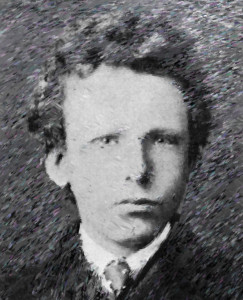By Lida Prypchan
 Vincent Willem van Gogh, born March 30, 1853, was the second child of protestant minister, Theodorus van Gogh, and his artist wife and bookseller’s daughter, Anna Cornelia Carbentus. Theodorus’ and Anna’s first child, a son, was stillborn one year before Vincent was born. That first son was also named Vincent. Although we may wonder why his parents bestowed upon Vincent the same name as his deceased older brother, he was actually named after his grandfather.
Vincent Willem van Gogh, born March 30, 1853, was the second child of protestant minister, Theodorus van Gogh, and his artist wife and bookseller’s daughter, Anna Cornelia Carbentus. Theodorus’ and Anna’s first child, a son, was stillborn one year before Vincent was born. That first son was also named Vincent. Although we may wonder why his parents bestowed upon Vincent the same name as his deceased older brother, he was actually named after his grandfather.
It was not uncommon during that era to reuse the name of a deceased child, especially if the name was common in a family. In this instance, not only were Vincent and his deceased older brother given the name, but Vincent’s grandfather, his grandfather’s uncle, and Vincent’s own uncle, his father’s brother, was also named Vincent. However, some of those interested in the effect of how a deceased child may play out on a subsequent child given the same name, as Vincent was. It has been theorized that Vincent’s upbringing as a “replacement” child was at least partially responsible for how he reflected upon his life.
Vincent’s parents also had four other children, Anna Cornelia, born in 1855; Theodorus, called Theo, Vincent’s younger brother, born on May 1, 1957; Elisabeth Huberta, called Lies, born in 1859; Willemina Jacoba, called Wil, born in 1862; and Cornelius Vincent, born in 1867. Vincent was particularly close to both Theo and Wil. During his most turbulent years, Theo supported Vincent both emotionally and sometimes financially, sharing with him his most secret thoughts via Vincent’s copious correspondence. Willemina and Vincent shared an even more indelible bond – mental illness. It is thought that Wil suffered from the same mental and emotional torment as Vincent.
According to the memoirs of his sister, Elisabeth, noted that Vincent was a quiet, serious, and sensitive child. He remained largely friendless throughout his life, preferring instead solitary pursuits such as nature watching, especially flowers, birds, and insects. Like many who are eventually diagnosed with a mental illness, Vincent was known as a “strange” child with odd eating habits and a preference for solitude. As is very common in cases of mental illness, Vincent’s eccentricities are understandable as explained in hindsight, but rather frustrating and worrisome in in foresight.
Born and raised in the largely Catholic village of Zundert, in the town of Noord Brabant, in the southern Netherlands, Vincent’s Protestant life did not appear to clash significantly with his Catholic surroundings. Like many individuals of the era and of the region, Vincent was very religious.
In 1860, at the age of seven, Vincent began school in the village and was taught by a Catholic teacher. In 1861, Vincent and his sister, Anna, were schooled at home by a governess. It is not clear why Vincent and Anna stopped attending the local school, but theories range from the family’s religious beliefs to their ability to afford the governess who taught the children. In October of 1864, Vincent was enrolled in Jan Provily’s boarding school, at a location more than 20 miles from home. This move much distressed Vincent because his internal nature made him a virtual outcast in his new surroundings.
